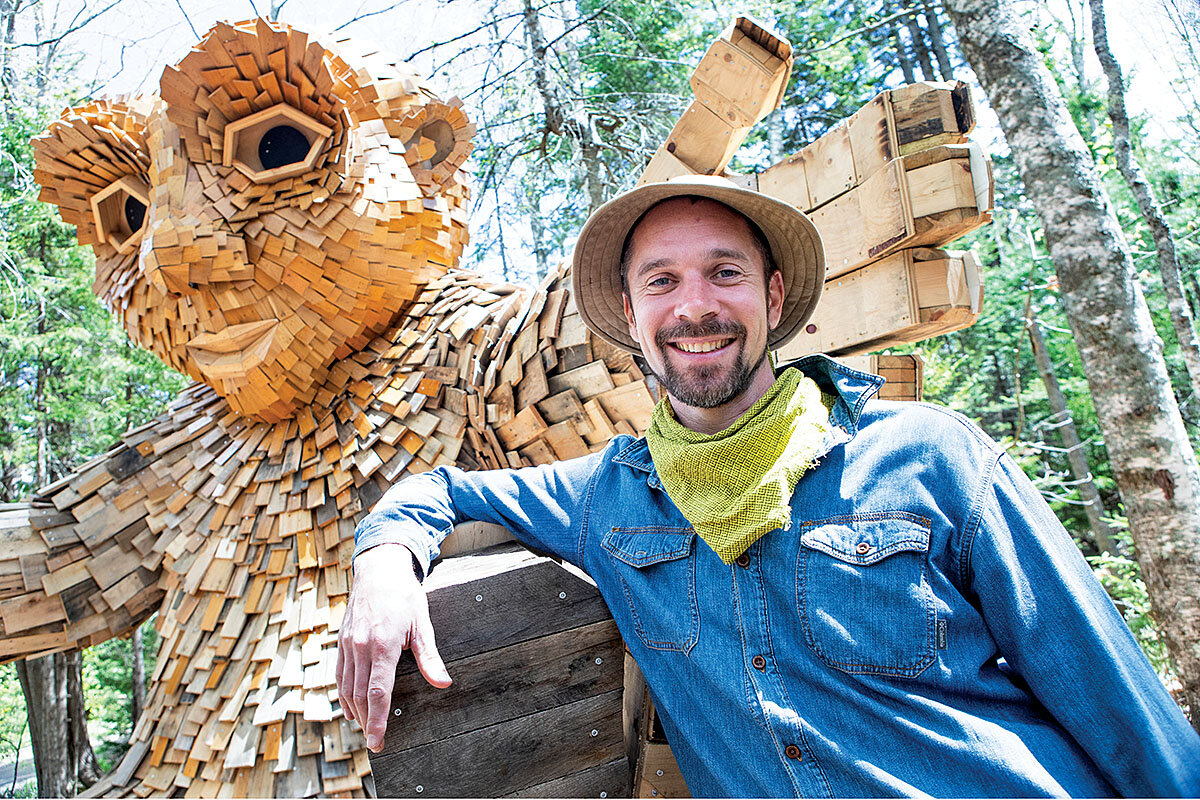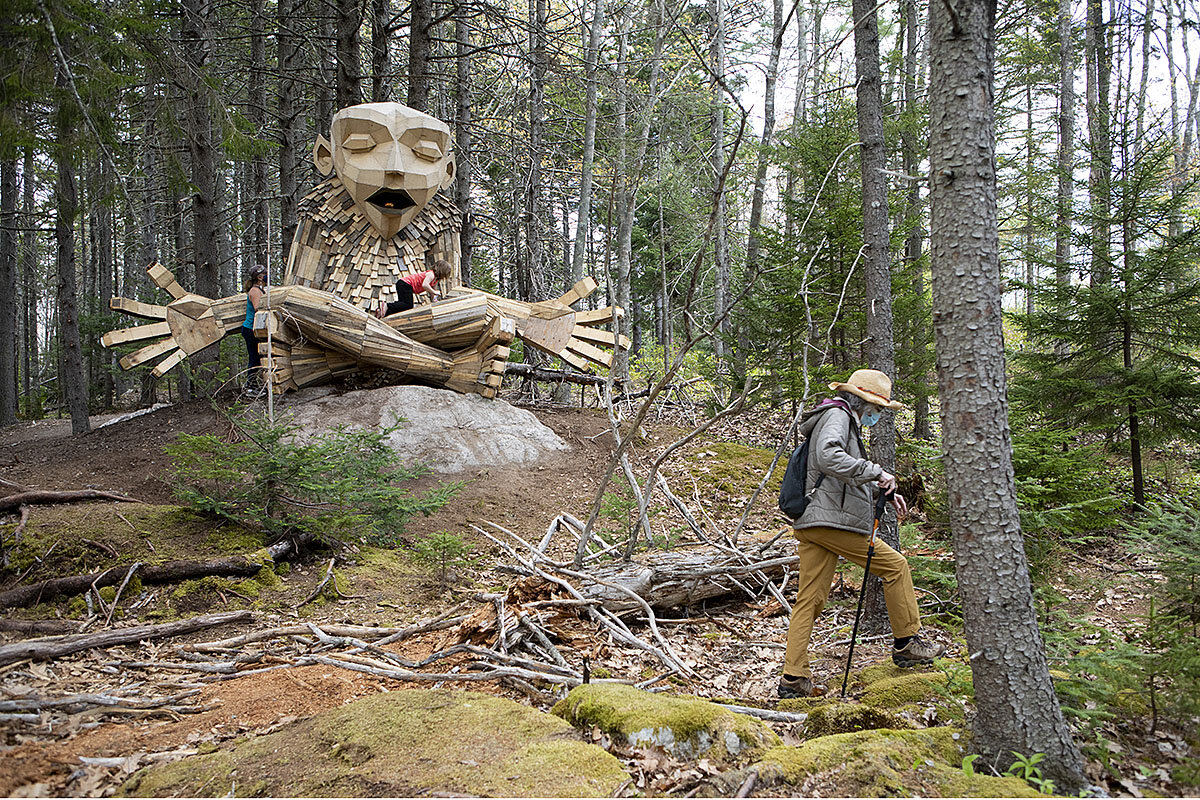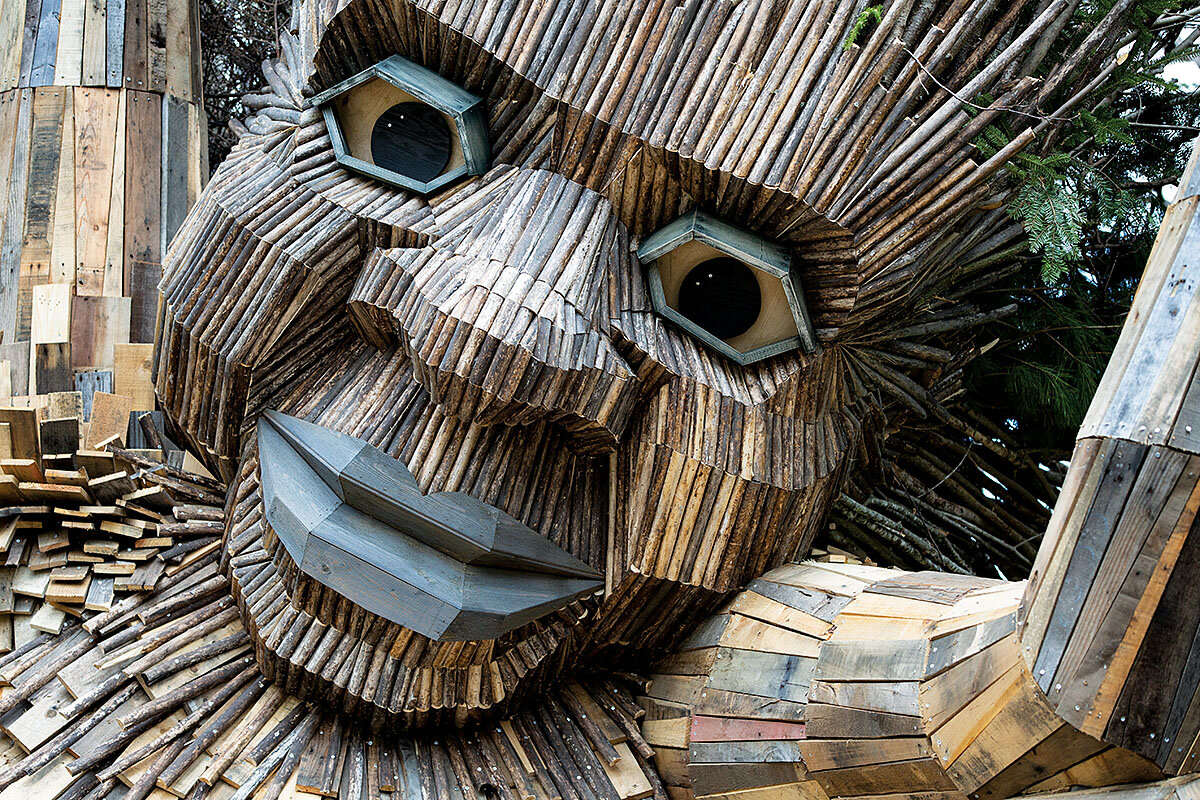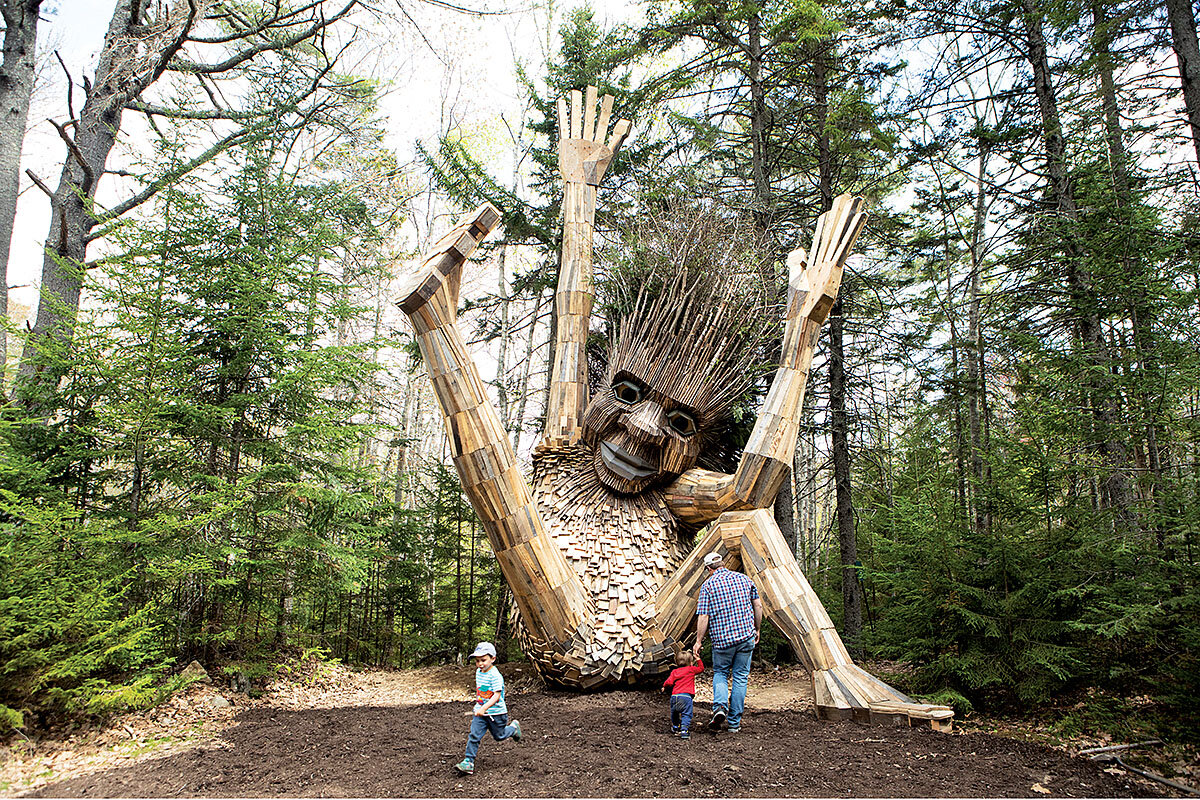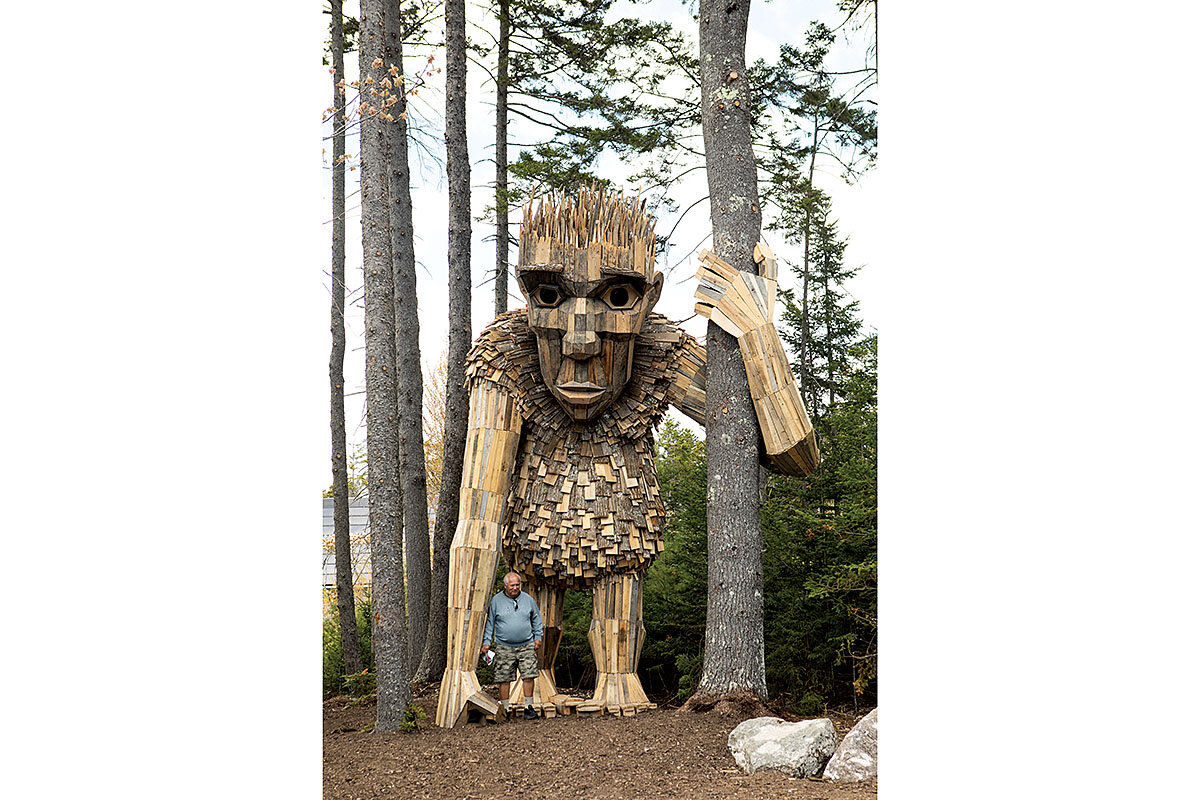With giant trolls, one artist preserves imagination – and the environment
Loading...
| Boothbay, Maine
Call it a troll safari. In the woods of Maine, a family of three is searching for creatures from Scandinavian folklore. Shaad and Andrea Breau survey a trail map as their young daughter, Eidi, bounds ahead of them. They won’t need binoculars to spot the trolls. This species would dwarf a Mack truck.
“Look, Mama,” exclaims Eidi, pointing at a 20-foot-tall wood sculpture of a troll looming between several pines. It’s like a scene out of Maurice Sendak’s “Where the Wild Things Are.”
“Is it made out of a tree?” asks Eidi.
Why We Wrote This
How can having a childlike view of the world help the environment? Danish eco-artist Thomas Dambo combines a flair for recycling with a fairy-tale imagination to bring people worldwide closer to nature.
Danish eco-artist Thomas Dambo built the spiky-haired troll, named Røskva, from discarded scraps of wood. It’s one of five trolls commissioned by Coastal Maine Botanical Gardens for its 323 acres of resplendent riverside woodland. The “Guardians of the Seeds” exhibition aims to give visitors an emotional connection with nature that will encourage them to become stewards of it.
Since 2014, Mr. Dambo has built dozens of unique trolls across the world, including in China, South Korea, and Puerto Rico. Each one is constructed from recycled materials from scrap yards and dumpsters. The key quality of his work? Its playfulness. For example, one of his trolls in Denmark sits astride a real car on a hillside, appearing to gleefully ride it like a sled. Mr. Dambo wants to reactivate a childlike imagination in adults so they begin to see trash as objects that can be repurposed in practical and even picturesque ways. And, yes, he loves to entertain kids, too.
“Thomas’ origin story is about being a kid and riding his bike, climbing trees, and scavenging for materials to build treehouses,” says Angela Del Monte, a graduate of the Copenhagen Business School who spent time with the artist for her 2020 master’s degree thesis, “Playing to His Strengths: A Case Study of Artist Entrepreneur Thomas Dambo.” “Thomas said he never stopped playing,” she adds.
But Mr. Dambo also discovered early on that some adults intrude on the world that children dream up. A schoolteacher once punished him for sitting in a window frame and gazing outside. He was forced to sit underneath the teacher’s table for the duration of a class. When Mr. Dambo’s mother heard about what happened, she transferred her son to a “hippie” school in the countryside. The boy quickly found a kindred spirit in one of his new teachers, Mogens Sigsgaard-Rasmussen.
“He would always sit up in the tree during classes and read us fairy tales,” recalls Mr. Dambo in a phone interview from Jackson Hole, Wyoming, where he’s building his 81st troll. “We would only spend two-thirds of the time doing school stuff. But we did a lot of learning by doing, so we would go out to build stuff out of wood.”
At lunchtime, Mr. Sigsgaard-Rasmussen would pass around a tray to collect all the scraps of food that fussy children didn’t want to eat because they thought it looked funny. Then he’d make a show of enjoying leftovers such as sandwiches filled with stinky cheese.
“He would also show us there was nothing wrong with the cheese,” recalls the artist. “One child would be afraid that another child would think that there is something wrong with me if I eat the cheese, because somebody else might say, ‘It’s smelly.’ So the reason I like this story is, of course, because it’s touching on a lot of the issues that we have with our trash and our recycling.”
Nowadays, Mr. Dambo relishes dumpster diving. In 2018, for instance, he visited several recycling plants in Mexico City to find stuff he could refashion into a plastic botanical garden called “The Future Forest.”
“I like showing people that trash doesn’t need to be a bad thing. It can be a beautiful thing,” he says. “I think that will solve a lot of our problems if we could just share things more and don’t only think that new objects are good objects.”
To challenge himself creatively, the artist allows for a degree of improvisation on-site. For “Guardians of the Seeds,” he gave a wizened troll named Birk a beard made from the roots of fallen trees. Røskva’s thatched fur is made from tiles of bark. Gro, who sits with her eyes closed in a serene yoga pose, has a copper tongue made out of a planter.
The artist came up with a story that this family of trolls hid 10 golden seeds to protect the old forest. Using a map that’s provided, visitors follow clues to find a secret place where those seeds are hidden.
“Thomas wants people to interact with these trolls,” says Gretchen Ostherr, president and chief executive officer of Coastal Maine Botanical Gardens. “He really wants it to be a journey of discovery where you’re walking along and all of a sudden this big magical being appears in front of you. These are friendly, happy trolls. They’re not scary, mean trolls under a bridge or on the internet.”
The Danish artisan hopes that “Guardians of the Seeds” gives viewers the same joy he gets from an occupation that he compares to a hobby. He says too many people lose their playfulness in the rough-and-tumble treadmill of adult life.
The Breau family, local members of the gardens, say they’d wanted to join the 150 volunteers who helped Mr. Dambo erect the trolls. But it didn’t work out. While they’re admiring Røskva, it starts to rain. They take shelter by dashing beneath the wooden statue’s vast girth.
“Thankfully, this troll was here to protect us,” Ms. Breau says to kindergarten-aged Eidi, who is clambering over Røskva’s tennis racket-sized toenails. The girl gazes up and yells, “Thanks, troll!”






